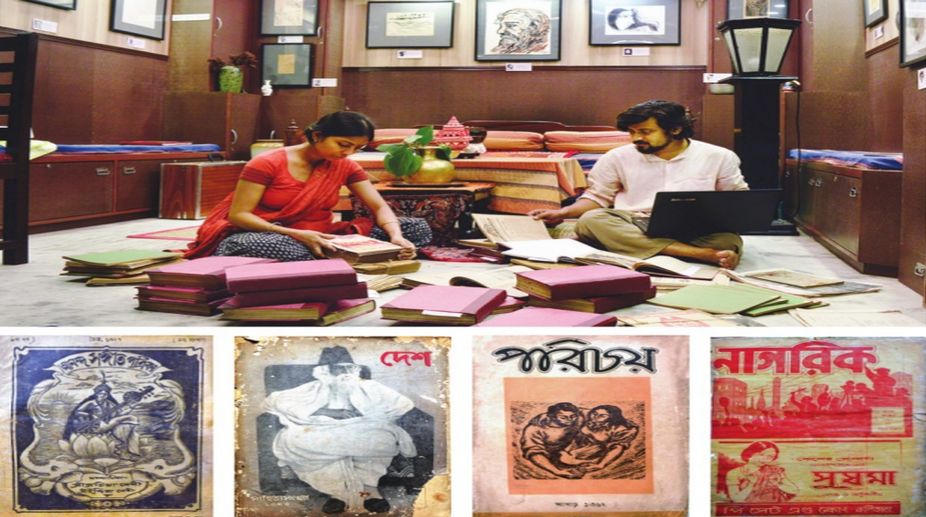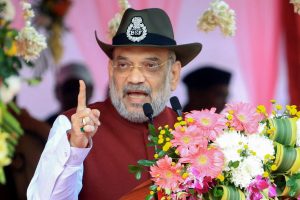Can you even imagine seeing 600 Bengali journals and periodicals ranging between 1920 and 1984 in one place? If not, then you better hurry to Jeebonsmriti Digital Archive in Uttarpara, a few kilometres from Kolkata, where Arindam Saha Sardar is in the process of building a massive digital archive of old and original Bengali magazines for some time now.
World Book Day is observed every year today and it would be ideal to shed light on this one-man archive. It offers a window to a new world to those who love to dig into our cultural and literary past that would have been lost without men like Sardar. Jeebonsmriti Digital Archive evolved from his original foundation Bengal Photo Studio based on his love for old films, cinema technicians of a bygone era, music records, song books of films, film scripts and screenplays, movie cameras and such like. He has made three good documentary films on classic cinematographers like Subrata Mitra and Soumendu Roy, and one of the best art directors of Indian cinema, Bansi Chandragupta.
In June 2011, he organised an exhibition on music, an offshoot of his research on 78 rpm records produced between 1902 and 1971. “These are considered to be the original records in the Indian recording industry. LPs and EPs and 45 rpm records are said to be copies. Recording companies stopped recording on 78 rpm from 1970 but a few offshoots came out in 1971. I wanted to make a documentary on this subject. In 2008, I began to interview people directly involved with the 78 rpm recording industry. These included collectors of 78 rpm records, music directors, singers, lyricists, music arrangers, recordists and even the head of Megaphone Company on camera. Private songs and film songs and all modern Bengali songs were within the subject of my research. I collected 78 rpm records, photographs, record players, restored the photographs on Photoshop and organised my first exhibition on ‘Female voices on gramophone records’. It was my second exhibition on music. We also brought out a CD for fans of old Bengali songs as a source of much needed revenue” Sardar says.
In 2014, under the auspices of the Baudhha Dharmankur Sabha, Sardar exhibited Chitre Tathagata with digitally restored prints of paintings collected from rare magazines, books and photo albums from the 19th and 20th centuries on the life of Tathagata (Buddha). On display were 112 digitally restored prints of the title pages of invaluable publications in Bengali on Lord Buddha. A similar exhibition was held in May to celebrate Buddha Purnima at Shantiniketan’s Rabindra Bhavan. This collection deserves place among the calligraphic, graphic and printing history of Bengal. Among the painters were Abanindranath Tagore, Gaganendranath Tagore, Asit Kumar Haldar and Srimati Gouribala Bhanja Choudhurani.
In 2015, Arindam gathered around 57 sketches and paintings in blackand-white and colour reproductions, published during the 19th and 20th centuries in Bengali magazines such as Bharat Barsha and Basumati, and the Bengali almanac printed and published by Gupta Press, which prides itself on a massive collection of sketches of different kinds of Durga. The Bengali almanac or Ponjika, as it is known in Bengali, is a historical archive unto itself. For the uninitiated, the Gupta Press Ponjika was first published in 1869 from Kolkata to fulfill the growing demand of having a codified book of ceremonies. It is like a detailed and precise frame of reference of lists, dates, times and events marked in the current calendar year for fixing the dates of marriages, thread ceremonies, rice ceremonies, funerals and everything else with which rituals are associated. Filled with illustrations in black-andwhite and executed often adapting the Kalighat pata school of painting, the Ponjika offers a peek at cultural and aesthetic history through its evolution as the most successful commercial venture where art has played a distinctive role.
Jeebonsmrit, in collaboration with Focus, another cultural organisation of Uttarpara, has ventured into further research in cultural media in the form of collecting old Bengali periodicals of different kinds and digitalising them for posterity. Together, Jeebonsmriti and Focus, since 2015, have been holding exhibitions, discussions, seminars and conferences exploring the cultural history of Bengal along different periods in the past.
An exhibition for the public was inaugurated on 16 April this year to coincide with the Bengali New Year by artists and historians Somendra Bandopadhyay and Anup Motilal where the bound volumes of the magazines are on display. “We are also arranging for researchers to get their material by email,” says Sardar who has christened this exhibition after a famous line from a Tagore song that goes, Nobo Anonde Jaago (Rise in Happiness Reborn).
The time span of these magazines ranges roughly between 1903 and 1964 while there are relatively recent publications of special editions for the birth and death anniversaries of eminent literary giants of Bengal. A digitalised list of these magazines with their names, cover images, list of contents, names of editors, and dates of issue is also being prepared.
This is also a journey through the history of magazines noting the time when advertisements began to feature at the bottom of covers. The names of eminent editors who were great literary figures in their own right are printed on some of the covers. The price tag takes one by surprise. The cover of Porichoy shows that the monsoon issue (Ashaad of 1362) of June-July 1955 was 10 annas before the naya paisa era had begun. Generous donations have come not only from individual collectors or families with their personal collections, but also from organisations and institutions that once kept these memorabilia in their collection as part of their interests and functioning. As a journalist, this writer found the collection of old, tattered, torn and faded print magazines in Bengali the most attractive and priceless among them all. “This archive is not based on my personal passion. It is aimed at creating a real, virtual library of academicians, historians, museum curators, and research students who can use these in digitalised form for their research. We are collecting them and putting them together over the last six months, trying to restore and rescue them from complete destruction and disintegration through proper and scientific techniques though we hardly have funds to finance this huge project,” Arindam says.











